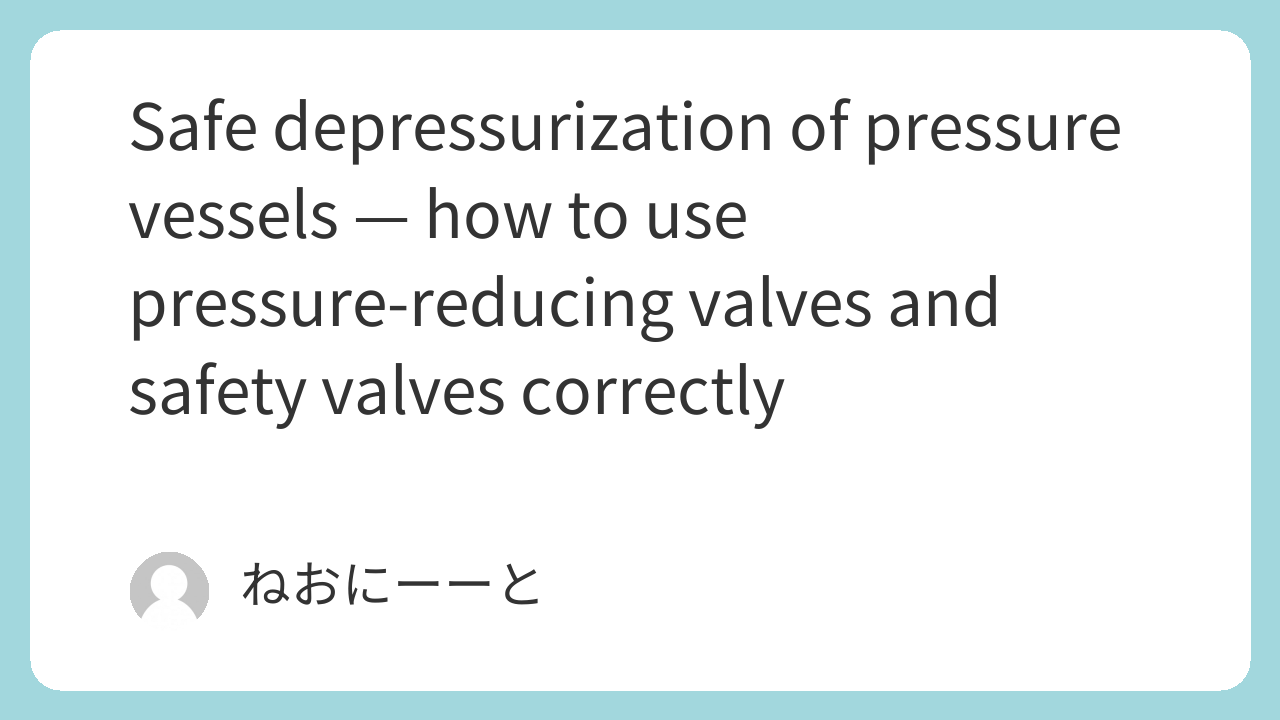Depressurizing vessels and piping is a routine operation in chemical plants, but “just lowering the pressure” can cause equipment damage or create a safety incident if valves are specified or operated incorrectly. Two different devices are often involved:
- Pressure-reducing (control) valves — used during normal operation to create and hold a lower downstream pressure.
- Safety (relief) valves — protect the vessel from overpressure (an emergency/exception condition).
Correct coordination between them during design and operation is essential. This article explains the critical terms and the practical checks you should do early in the project.
Typical flow / setup example
A common design chain is:
- Source: 0.50 MPa steam/gas
- Pressure reducing valve (PRV) reduces to 0.10 MPa (normal downstream pressure)
- Safety valve (relief) set ≈ 0.18 MPa to protect the vessel
- Vessel design (MAWP) = ~0.20 MPa
This shows how PRV set points, safety valve set points, and vessel design pressure must be aligned — a mismatch leads to nuisance relief or unsafe conditions.
Safety valves — the three pressures you must know
Safety-valve terminology in English commonly uses these terms:
- Cracking (or “crack” / “cracking pressure”)
The pressure at which the valve first allows a small leakage — the valve starts to open. (Japanese: 吹始め圧力) - Popping / Full-lift (blowout) pressure
The pressure when the valve snaps fully open and flow becomes substantial. This is normally what plant staff think of as the “valve set pressure.” (Japanese: 吹出し圧力) - Reseat (reseat) pressure
The pressure at which the valve closes again after relieving. It is lower than the popping pressure. (Japanese: 吹止り圧力) - Blowdown
The difference between popping pressure and reseat pressure; usually expressed as absolute or percent of set pressure.
Design notes:
- Safety valves are sized and specified for the worst credible overpressure case.
- For steam/gas spring valves outside boilers, typical tolerances and blowdown percentages exist — check manufacturer data.
- Always ensure the safety valve set/popping pressure does not exceed the vessel MAWP (design pressure) plus allowed margin.
Pressure-reducing valves (PRVs) — what to watch for
Key PRV terms to understand:
- Set (downstream) pressure — the target pressure you want to maintain downstream (e.g., 0.10 MPa).
- Shutoff pressure (closing pressure / “shut-off”) — the pressure that can be reached on the downstream side when the PRV is closing or closed. Because of the valve mechanics (spring, pilot, backpressure, etc.) the shutoff behavior can produce higher downstream pressure spikes than naïvely expected.
Why this matters: if the PRV’s shutoff (or any transient overshoot) allows downstream pressure to momentarily exceed the safety valve popping pressure, the safety valve will lift — producing nuisance or unintended relief events. In batch plants where flow/loads change rapidly, this scenario is common if the interaction is not checked.
Coordination rules (practical)
- Chain logic: verify the chain: Source → PRV → Vessel → Safety valve. Specify pressures using both set and actual expected operating/residual pressures.
- Ensure safety valve popping pressure < vessel MAWP (and in practice you set safety valve ≤ MAWP).
- Check PRV shutoff/overpressure behavior — make sure downstream transients will not cause the safety valve to operate unintentionally.
- Consider backpressure/steady and variable backpressure — some relief valves are sensitive to backpressure; this changes reseat and popping characteristics.
- Include blowdown/reseseat in spec so you can verify the assembly later.
- Have valve manufacturer review the system (setpoints, expected transients, backpressure conditions). They typically will recommend spring ranges or pilot types to match your application.
- Test after installation — bench setting plus in-plant functional checks.
Other important terms (vessel testing & pressures)
- Design pressure / MAWP (Maximum Allowable Working Pressure) — the pressure the vessel is designed for; valves must be coordinated with this.
- Leak (pneumatic) test pressure — used for leakage checks; be cautious: pneumatic tests can be hazardous (use appropriate procedures).
- Hydrostatic test pressure — often specified as a multiple of design pressure (commonly ~1.5× in many codes; check applicable code). Hydrostatic tests should follow procedures and safety precautions.
Safety note: overpressurizing for testing or incorrect test procedures can be dangerous — follow codes, standards and site procedures.
Common pitfalls observed in practice
- Designing piping first then realizing at procurement that valve setpoints conflict — coordinate early.
- Assuming PRV downstream pressure simply equals setpoint under all conditions (transients change reality).
- Treating safety valves as a “backup” after the fact instead of integrating them into initial design.
- Not accounting for multiple relief paths or interactions between several PRVs and relief valves on a skid.
Quick practical checklist (what to do now)
- During design phase, document: upstream pressure, desired downstream pressure, expected fluctuations, vessel MAWP, relief scenario (maximum credible overpressure).
- Ask valve vendors for pop/crack/reseat and blowdown spec and confirm they match the system.
- Ensure the safety valve set pressure is less than or equal to vessel MAWP.
- Confirm PRV shutoff/overpressure behavior and that transient spikes cannot open the safety valve in normal operation.
- Record setpoints and label valves on site; implement a verification/test procedure.
Summary
Depressurization is routine but requires correct specification and coordination of PRVs and safety valves. Safety valves protect against emergency overpressure; PRVs control normal operating downstream pressures. Misaligned setpoints or ignored transient/shutoff behaviors cause nuisance relief or unsafe conditions. Involve valve manufacturers early, specify pop/crack/reseat/blowdown, and verify in the field.

Comments